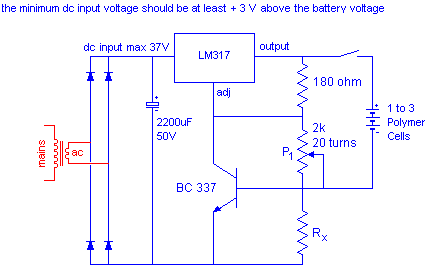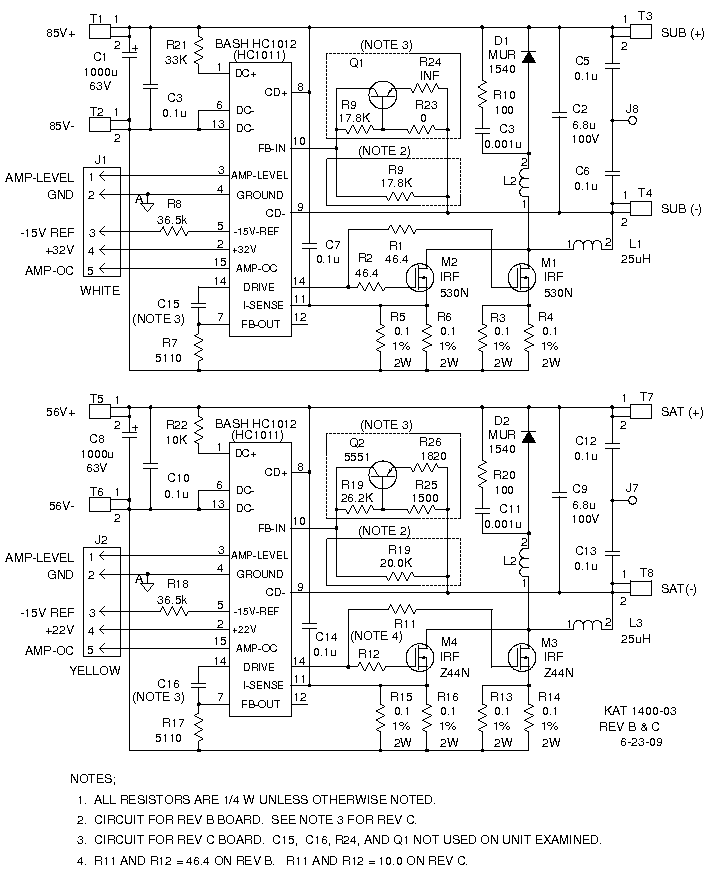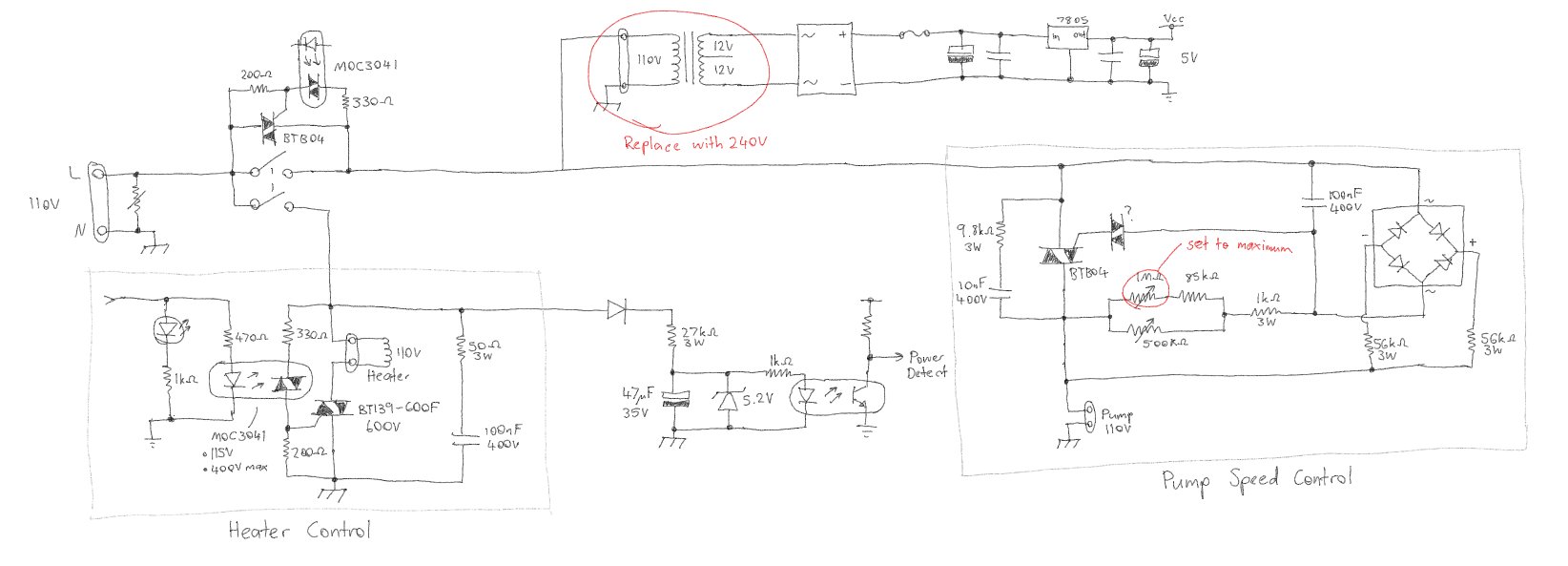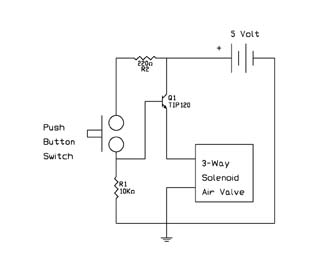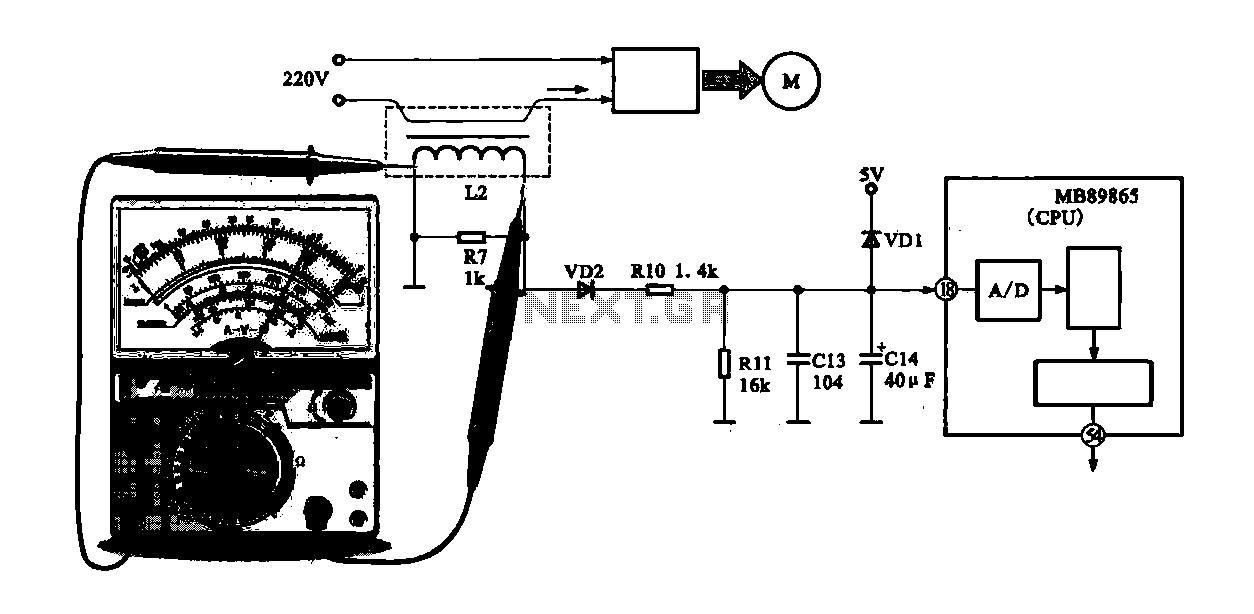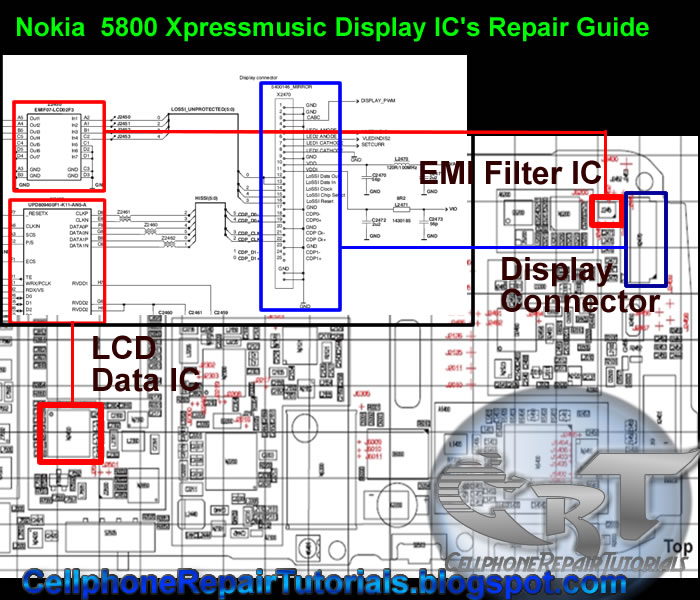
SASS 2400 Low-Volume Wet Air Sampler
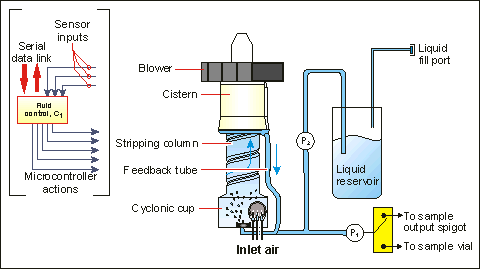
A schematic representation of the SASS 2400 is shown in Figure 2 below. The cyclone has four main sections: a cyclonic cup, stripping column, cistern, and water feedback loop. A high-efficiency, brushless centrifugal blower at the cyclone exit pulls air into the unit. When the SASS is turned on, the blower is activated, and a water charge is injected into the cyclonic cup from a fresh water reservoir. Incoming air enters at the cup perimeter, creating strong vortex action and a rapidly swirling film of water on exposed surfaces. The water film passes across the air inlet region, forming a water curtain through which air must pass. Concurrently, a centrally located port in the cup base injects additional water. This location is subject to high air shear, and fluid discharged from the port into the cup will be in the form of a fine spray. The cup plays a major role in the collection of sub-micron particles and molecular species due to the intimate two-phase contact provided, whereas larger respirable particles are captured in both the cup and a stripping column to be described. The air stream then flows from the cup into a stripping column connected to the cup's upper surface. As air enters the smaller diameter stripping column, it increases in rotational velocity, enhancing particulate collection through centrifugal action. The inner surface of the stripping column is also wet by fluid outflow from the cup. The airflow rate and column inside diameter have been designed so that adequate shear force is produced to create a cocurrent upward flow of water on the column wall. The stripping column is operated beyond the so-called flooding limit, meaning that liquid introduced at the base of the column cannot flow opposite to the upwelling air and must flow up the stripping column. Water flows from the stripping column into a larger diameter cistern section located above the stripping tube. Due to parasitic shear forces created by the rotating airflow, water transitioning from the tube to the cistern is flung outward to a water trap zone where a rapidly rotating water ring is formed. Water in the ring flows back to the cyclonic cup by way of a liquid feedback tube. This water is re-injected into the cup via the previously mentioned port, where it is once again available to collect additional particulates. The nominal liquid sample inventory needed to wet all key surfaces is only 1.0 cc and is automatically maintained by a proprietary liquid level control circuit described below. Fluid re-circulation rates have been measured to be in the range of 1 to 2 ml/minute. This means a typical 1 cc water inventory is re-circulated through the unit from 1 to 2 times per minute of operation. Aerosol collection characteristics are similar to those of the SASS 2300, with significant particle retention over very long collection periods of up to several hours. Collection efficiency is typically 70% for three micron particles, decreasing to 50% at a particle size between 1 to 2 microns, and approaching a maximum of about 90% as particle size increases. The maximum particle size that can be collected is essentially unlimited. To prevent clogging of the liquid feedback tube, it is recommended that objects of greater than 1 mm diameter be excluded from capture through the use of an external filter or screen cover on the inlet. The particle extraction process involves intimate mixing of incoming air with recirculating sample water. All water would be lost in a short time if no attempt were made to compensate for evaporation. To prevent drying out, the liquid volume is monitored with a proprietary sensor attached to the water feedback tube. When the sample water inventory falls below a preset level, a microprocessor-controlled peristaltic pump meters a small amount of clean water into the re-circulation loop from an onboard water reservoir to bring the level back to set point.
The SASS 2400 system is designed to efficiently capture airborne particulate matter utilizing a combination of centrifugal force and liquid filtration. The cyclonic cup serves as the initial collection chamber where incoming air is subjected to intense vortex action. This action not only facilitates the capture of sub-micron particles but also ensures that larger particles are retained within the system. The integration of a brushless centrifugal blower enhances the airflow dynamics, allowing for a consistent and controlled air intake.
The stripping column's design is critical for maximizing particulate collection efficiency. As the air transitions into the column, it experiences an increase in rotational velocity, which is essential for enhancing the centrifugal forces acting on the particles. The wetting of the column's inner surface with recirculated water ensures that particles are effectively captured and prevents them from re-entering the airstream.
The cistern section plays a vital role in managing the water used in the collection process. The innovative water feedback loop allows for continuous recirculation of the liquid, maintaining the necessary volume to ensure effective filtration without excessive water loss. The proprietary liquid level control circuit is essential for automating the water replenishment process, ensuring that the system operates optimally without manual intervention.
Overall, the SASS 2400 is engineered for high efficiency in aerosol collection, with a design that allows for the capture of a wide range of particle sizes while minimizing the risk of clogging and maintaining operational efficiency through advanced liquid management techniques. The system's ability to handle various particulate sizes and its automated features make it suitable for extended operational periods, providing reliable performance in environments where air quality management is essential.A schematic representation of the SASS 2400 is shown in Figure 2 below. The cyclone has four main sections: a cyclonic cup, stripping column, cistern, and water feedback loop. A high-efficiency, brushless centrifugal blower at the cyclone exit pulls air into the unit. When the SASS is turned on, the blower is activated and a water charge is inject ed into the cyclonic cup from a fresh water reservoir. Incoming air enters at the cup perimeter, creating strong vortex action and a rapidly swirling film of water on exposed surfaces. The water film passes across the air inlet region, forming a water curtain through which air must pass.
Concurrently, a centrally located port in the cup base injects additional water. This location is subject to high air shear, and fluid discharged from the port into the cup will be in the form of a fine spray. The cup plays a major role in collection of sub-micron particles and molecular species due to the intimate two-phase contact provided, whereas larger respirable particles are captured in both the cup and a stripping column to be described.
The air stream then flows from the cup into a stripping column connected to the cup`s upper surface. As air enters the smaller diameter stripping column it increases in rotational velocity, enhancing particulate collection through centrifugal action. The inner surface of the stripping column is also wet by fluid outflow from the cup. The airflow rate and column inside diameter have been designed so that adequate shear force is produced to create a cocurrent upward flow of water on the column wall.
The stripping column is operated beyond the so-called flooding limit, ` meaning that liquid introduced at the base of the column cannot flow opposite to the upwelling air, and, in fact, must flow up the stripping column. Water flows from the stripping column into a larger diameter cistern section located above the stripping tube.
Due to parasitic shear forces created by the rotating airflow, water transitioning from the tube to the cistern is flung outward to a water trap zone where a rapidly rotating water ring is formed. Water in the ring flows back to the cyclonic cup by way of a liquid feedback tube. This water is re-injected into the cup via the previously mentioned port, where it is once again available to collect additional particulates.
The nominal liquid sample inventory needed to wet all key surfaces is only 1. 0 cc, and is automatically maintained by a proprietary liquid level control circuit described below. Fluid re-circulation rates have been measured to be in the range of 1 to 2 ml/minute. This means a typical 1 cc water inventory is re-circulated through the unit from 1 to 2 times per minute of operation. Aerosol collection characteristics are similar to those of the SASS 2300, with significant particle retention over very long collection periods of up to several hours.
Collection efficiency is typically 70% for three micron particles, decreasing to 50% at a particle size between 1 to 2 microns, and approaching a maximum of about 90% as particle size increases. The maximum particle size that can be collected is essentially unlimited. To prevent clogging of the liquid feedback tube, it is recommended that objects of greater than 1 mm diameter be excluded from capture through the use of an external filter or screen cover on the inlet.
The particle extraction process involves intimate mixing of incoming air with recirculating sample water. All water would be lost in a short time if no attempt were made to compensate for evaporation. To prevent dry out, the liquid volume is monitored with a proprietary sensor attached to the water feedback tube.
When the sample water inventory falls below a preset level, a microprocessor-controlled peristaltic pump meters a small amount of clean water into the re-circulation loop from an onboard water reservoir to bring the level back to set point. Water inve 🔗 External reference
The SASS 2400 system is designed to efficiently capture airborne particulate matter utilizing a combination of centrifugal force and liquid filtration. The cyclonic cup serves as the initial collection chamber where incoming air is subjected to intense vortex action. This action not only facilitates the capture of sub-micron particles but also ensures that larger particles are retained within the system. The integration of a brushless centrifugal blower enhances the airflow dynamics, allowing for a consistent and controlled air intake.
The stripping column's design is critical for maximizing particulate collection efficiency. As the air transitions into the column, it experiences an increase in rotational velocity, which is essential for enhancing the centrifugal forces acting on the particles. The wetting of the column's inner surface with recirculated water ensures that particles are effectively captured and prevents them from re-entering the airstream.
The cistern section plays a vital role in managing the water used in the collection process. The innovative water feedback loop allows for continuous recirculation of the liquid, maintaining the necessary volume to ensure effective filtration without excessive water loss. The proprietary liquid level control circuit is essential for automating the water replenishment process, ensuring that the system operates optimally without manual intervention.
Overall, the SASS 2400 is engineered for high efficiency in aerosol collection, with a design that allows for the capture of a wide range of particle sizes while minimizing the risk of clogging and maintaining operational efficiency through advanced liquid management techniques. The system's ability to handle various particulate sizes and its automated features make it suitable for extended operational periods, providing reliable performance in environments where air quality management is essential.A schematic representation of the SASS 2400 is shown in Figure 2 below. The cyclone has four main sections: a cyclonic cup, stripping column, cistern, and water feedback loop. A high-efficiency, brushless centrifugal blower at the cyclone exit pulls air into the unit. When the SASS is turned on, the blower is activated and a water charge is inject ed into the cyclonic cup from a fresh water reservoir. Incoming air enters at the cup perimeter, creating strong vortex action and a rapidly swirling film of water on exposed surfaces. The water film passes across the air inlet region, forming a water curtain through which air must pass.
Concurrently, a centrally located port in the cup base injects additional water. This location is subject to high air shear, and fluid discharged from the port into the cup will be in the form of a fine spray. The cup plays a major role in collection of sub-micron particles and molecular species due to the intimate two-phase contact provided, whereas larger respirable particles are captured in both the cup and a stripping column to be described.
The air stream then flows from the cup into a stripping column connected to the cup`s upper surface. As air enters the smaller diameter stripping column it increases in rotational velocity, enhancing particulate collection through centrifugal action. The inner surface of the stripping column is also wet by fluid outflow from the cup. The airflow rate and column inside diameter have been designed so that adequate shear force is produced to create a cocurrent upward flow of water on the column wall.
The stripping column is operated beyond the so-called flooding limit, ` meaning that liquid introduced at the base of the column cannot flow opposite to the upwelling air, and, in fact, must flow up the stripping column. Water flows from the stripping column into a larger diameter cistern section located above the stripping tube.
Due to parasitic shear forces created by the rotating airflow, water transitioning from the tube to the cistern is flung outward to a water trap zone where a rapidly rotating water ring is formed. Water in the ring flows back to the cyclonic cup by way of a liquid feedback tube. This water is re-injected into the cup via the previously mentioned port, where it is once again available to collect additional particulates.
The nominal liquid sample inventory needed to wet all key surfaces is only 1. 0 cc, and is automatically maintained by a proprietary liquid level control circuit described below. Fluid re-circulation rates have been measured to be in the range of 1 to 2 ml/minute. This means a typical 1 cc water inventory is re-circulated through the unit from 1 to 2 times per minute of operation. Aerosol collection characteristics are similar to those of the SASS 2300, with significant particle retention over very long collection periods of up to several hours.
Collection efficiency is typically 70% for three micron particles, decreasing to 50% at a particle size between 1 to 2 microns, and approaching a maximum of about 90% as particle size increases. The maximum particle size that can be collected is essentially unlimited. To prevent clogging of the liquid feedback tube, it is recommended that objects of greater than 1 mm diameter be excluded from capture through the use of an external filter or screen cover on the inlet.
The particle extraction process involves intimate mixing of incoming air with recirculating sample water. All water would be lost in a short time if no attempt were made to compensate for evaporation. To prevent dry out, the liquid volume is monitored with a proprietary sensor attached to the water feedback tube.
When the sample water inventory falls below a preset level, a microprocessor-controlled peristaltic pump meters a small amount of clean water into the re-circulation loop from an onboard water reservoir to bring the level back to set point. Water inve 🔗 External reference
